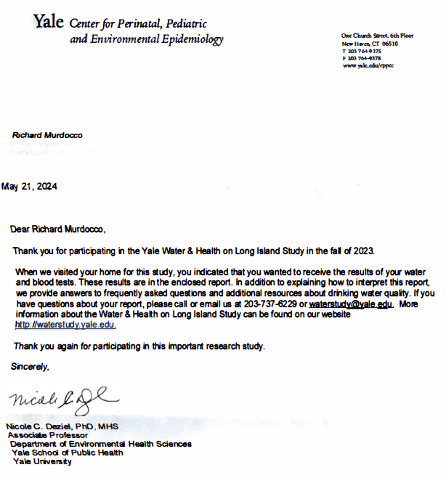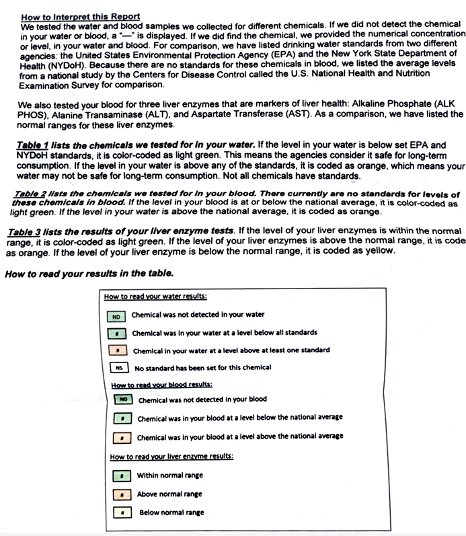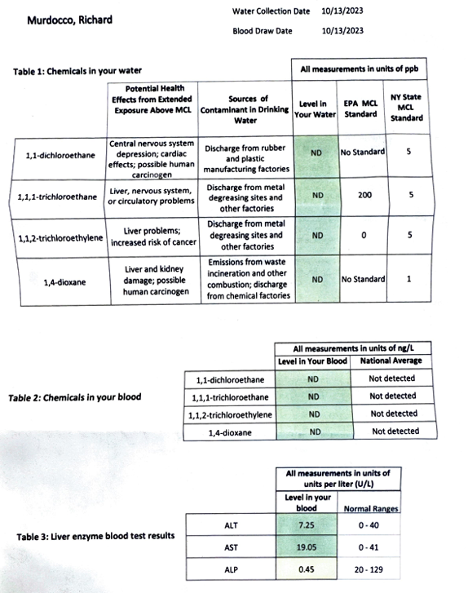The following was exclusively published by The Foggiest Idea on June 7, 2024. Interested in supporting The Foggiest Idea’s award-winning reporting and analysis? Click here.
BY RICHARD MURDOCCO
My blood test results came back in a cream-colored textured envelope, complete with a light blue font with high-quality raised lettering.
In the Fall of 2023, I volunteered to participate in a long-term study conducted by the Yale School of Public Health seeking to understand how levels of environmental chemicals, particularly 1,4-Dioxane, found in Long Island’s drinking water would affect human blood as well as other health measures.
And so, last October, Yale researchers came over to my house within the Town of Smithtown to conduct an in-home screening. They ran the kitchen tap continuously to take various samples and interviewed me in detail. Their questions included what type of soaps I used to wash dishes and take showers (Palmolive and Irish Spring), how much water I drank daily (a ton), if our home had a filtration setup (none, aside from the basic little one in the fridge that always seems to need to be replaced), and a bunch of other lifestyle indicators.
I was transparent with the team about my professional background: I study the relationship between land use and water quality, and I teach the subject at Stony Brook University. Based on my responses, it turns out I’m simply no fun. I go to bed early; I don’t imbibe or smoke. But I did discover that our household relies daily on a large amount of our region’s groundwater.



Pictured: Water and blood testing results from a study conducted by the Yale School of Public Health. The study’s purpose was to detect abnormalities related to “forever” chemicals. Source – Richard Murdocco/TFI
According to the Yale School of Public Health study, the water at our home was not only free of polyfluoroalkyl substances, or PFAS—the “forever chemicals” that the researchers were hunting for—but it also found that despite my drinking from the local water supply my entire life, my blood tests showed no abnormalities.
Like countless other households here, we get our fresh water from the Suffolk County Water Authority, which has been consistently hiking rates in recent years.
The average SCWA ratepayer in 2024 is slated to pay about $574 per year for water, compared to paying about $557 per year in 2023, a 2.99% increase. There was a 4.1% rate hike the year prior to that.
These rate increases are partly due to the cost of combating the forever chemical problem because these substances are extremely difficult to eliminate once they’ve contaminated the environment.
After seeing the results of my bloodwork, I contend that the increased costs are well worth the clean bill of health that the water supply (from this particular SCWA well-field at least) as well as myself both received.
I’m still surprised by my screening results, and I feel reassured that our household’s water is safe to drink. But I worry about other families in Nassau and Suffolk Counties whose results may not turn out so favorably.
When I was in graduate school, I had the great opportunity to study with Dr. Lee Koppelman, Long Island’s veteran planner and the chief architect of Suffolk’s pioneering studies into the interrelationship among land use, wastewater and open space protection. Koppelman had always argued that Suffolk County’s potable water supply ranked among the best in the world. He often noted that our local public municipal providers continually tested and regulated their fresh water supplies to the highest standards by using then-pioneering technologies to detect all sorts of nastiness.
But now the emergence of “new” contaminants and the increasing detection of forever chemicals that simply don’t break down have changed the calculus significantly since Koppelman’s team of planners first began to study the issue in the late 1970s.
As it turned out, 1,4-Dioxane, which was once simply regarded as an industrial by-product, was everywhere, with the substance being discovered in alarming quantities in things like soaps, cosmetics, and containers.
In recent years, public awareness of the challenges that Long Island’s groundwater aquifers face has grown, thanks, in part, to the ever-evolving regulatory framework on both the state and federal level that has become more aggressive in reigning in substances like 1,4-Dioxane, as well as PFAS like perfluoroalkyl and polyfluoroalkyl.
The most recent federal rules, which the U.S. Environmental Protection Agency proposed in April of this year, set a limit for these two types of PFAS at 4 parts per trillion each in public drinking-water systems nationwide. In addition, the EPA said it is moving to regulate four other PFAS chemicals, which could require additional treatment if their combined levels reach a certain concentration.
The long-term impact of these substances on our natural environment is just now beginning to be more fully understood.
Our policymakers have spent decades trying to ensure that Long Island’s drinking water remains potable for the foreseeable future. And that battle must never be lost.
Recently Suffolk County lawmakers have begun trying to fund additional protection measures against nitrogen loadings that come from wastewater, which is another longstanding threat to our region’s waters, via the imposition of a 0.125% increase in the county’s sales tax. This additional money would be used to expand our sewers and install high-tech septic systems.
Initially, this effort—part of Suffolk’s broader $4 billion, 50-year Subwatersheds Wastewater Plan—got bogged down in legislative politicking during the heated 2023 campaign season, but since the election, Suffolk County Executive Ed Romaine has given it a renewed focus. In recent days, the proposal gained significant momentum, when the Suffolk County Legislature approved a referendum measure to place the new tax bump on the ballot for public consideration. If voters approve the deal this November, the tax increase will remain in effect until 2060.
As The Foggiest Idea has previously reported, Suffolk policymakers anticipate that raising the drinking water sales tax would generate $57.8 million within the first year alone, and that a whopping $3.1 billion could be raised between 2024 and 2060. In the real world, it amounts to adding 12 cents to every $100 purchase, or like just a few drops of water in a very tall glass.
By supporting the upcoming county referendum, we Suffolk County residents can take significant collective action to protect our groundwater for many more years to come. As the EPA ramps up enforcement of its new standard for forever chemicals, we will likely need to broaden the scope of our efforts to curb their presence in our water supply, which may well result in more tax hikes to fund them. But the cost of doing nothing could prove fatal.
As for me, I was very relieved to learn that my own test results came out so clean. But many other Long Islanders may not be as fortunate to have safe water to drink at their homes.
If policymakers fail to act now, they will take their responsibility to be our stewards of public health and flush their duty down the drain.
Richard Murdocco is an award-winning columnist and adjunct professor in Stony Brook University’s public policy graduate program and School of Marine and Atmospheric Sciences. He regularly writes and speaks about Long Island’s real estate development issues. You can connect with him on LinkedIn.








